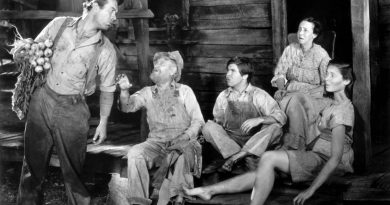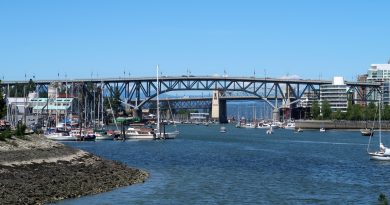Events of 1951
The 1951 census showed that Metropolitan Vancouver had a population of 584,830, just barely squeaking past 50 per cent of the province’s total of 1,165,200. These figures are a reminder of how rapidly the city’s suburbs have grown since 1951, when the population of the city totaled nearly 60 per cent of the metropolitan area. In 2007 the percentage was more like 27 per cent.
In 1951 Anmore, Belcarra and White Rock didn’t exist yet and Fraser Mills, which did, would be later annexed to Coquitlam.
1951 census figures (with 2006 census figures in bold)
| Burnaby | 58,376 | (202,799) |
| Coquitlam | 15,697 | (112,890) |
| Delta | 6,701 | (96,723) |
| Fraser Mills | 369 | (annexed to Coquitlam in 1971) |
| Langley City | 2,025 (1955 figure) | (23,606) |
| Langley Township | 12,267 | (93,726) |
| Maple Ridge | 9,891 | (68,949) |
| New Westminster | 28,639 | (58,549) |
| North Vancouver City | 15,687 | (45,165) |
| North Van. District | 14,467 | (82,562) |
| Pitt Meadows | 1,434 | (15,623) |
| Port Coquitlam | 3,232 | (52,687) |
| Port Moody | 2,246 | (27,512) |
| Richmond | 19,186 | (174,461) |
| Surrey | 33,670 (included White Rock) | (394,976) |
| Vancouver | 344,833 | (578,041) |
| UEL | 2,120 | (8,034) Includes other bits and pieces |
| West Vancouver | 13,990 | (42,131) |
| TOTAL | 584,830 | |
| Anmore (inc. 1987) | 1,785 | |
| Belcarra (inc. 1979) | 676 | |
| Bowen Island (uninc.) | 3,362 | |
| Lions Bay (inc. 1971) | 1,328 | |
| White Rock (inc. 1957) | 18,755 | |
| Metropolitan Vancouver (2006) TOTAL | 2,104,340 |
One of the results, by the way, of the growth of Vancouver and other Canadian cities was the introduction in August of 1951 for the first time of postal zones, but this was an early two-digit form that bears no relation to our present system.
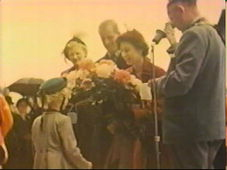
We don’t know how many of those people crammed the streets of the city on October 20, 1951 when we enjoyed a visit by Princess Elizabeth and Prince Philip, but there were many thousands. It was Elizabeth’s first visit to the city, Philip’s second. (He’d been here briefly as a naval officer during the Second World War.) They stepped off their special CPR train at 10:00 a.m., and were officially welcomed by Lieutenant-Governor Clarence Wallace, Premier Byron Johnson and Vancouver’s mayor, Fred Hume. During a visit to city hall a few minutes later they had an opportunity to chat with Victoria Cross winner Sgt. E.A. “Smokey” Smith. Following lunch at the Hotel Vancouver the royal party left for Stanley Park where they were greeted at Brockton Oval by a few thousand cheering children. There is a brief and charming video in the BC Archives showing the Princess and Duke greeting two small children bringing them flowers. CBC announcer Gordon Inglis can be heard, and we see Mayor Hume protecting the Princess from the rain. The same web site has a brief clip of a speech given by Elizabeth.
A CBC film of the tour next shows them being driven along streets jammed by many thousands more in the rain—this was in a day when a royal tour could generate intense excitement—toward Shaughnessy Hospital. At the hospital the Princess and Philip would be greeted by George Derby of the Department of Veterans Affairs, and be taken on a tour of the wards to speak with the veterans there.
Crowds had been big on every day of their tour across the country—reaching an estimated 500,000 in Toronto alone. Incidentally, the royal couple had attended a hockey game at Maple Leaf Gardens while they were in Toronto. Not to be outdone, UBC put on a football game—Canadian football—for them at Thunderbird Stadium. They didn’t stay for the whole game, but later that evening they did stay much longer than scheduled at a lacrosse game at the Forum between the New Westminster Commandos and the Vancouver Combines. This was the first time they’d seen lacrosse played and Princess Elizabeth really enjoyed it. Reporter Stan Shillington wrote: “After the first period, her private secretary leaned over and asked if she were ready to leave. ‘We have no other engagements this evening and I’m enjoying the game,’ replied the princess. ‘We stay to the end.’”
The Vancouver Police Department’s Mounted Squad, which had been disbanded in 1949, was “hastily and temporarily re-established” to provide an escort for Elizabeth and Philip for a tour of Stanley Park. (The squad would be permanently re-established in 1953.)
The couple visited Queen Elizabeth Park, too. It had been named for her mother on the 1939 royal visit by King George VI and Elizabeth, the Queen Mother. The younger Elizabeth planted a tree, an English oak, there. It stands to this day by the duck pond. And while they were in BC, the royal couple went over to Victoria October 21 on HMCS Crusader.
Prince Charles, not quite three years old, and Princess Anne, one, had stayed behind in England. It was little known at the time, but Princess Elizabeth, 25, had with her an Accession Declaration in case her ailing father, King George VI, died while she was in Canada. In the event, she would become Queen less than four months after her Vancouver visit, following the King’s death February 6, 1952.
We mentioned George Derby above. That name will have a familiar ring to many of you: he was the Western Regional Administrator in Vancouver for the Department of Veterans Affairs, which had been formed in 1944. In that capacity, in 1946 he had negotiated the land acquisition for a new veterans’ hospital in Vancouver, and that’s why it was named for him. The original centre had been opened in 1947 as part of the Shaughnessy Hospital complex. In 1988 a new George Derby Centre—now under provincial control—would be opened in Burnaby as an intermediate care facility with 300 beds for veterans.
Elizabeth and Philip didn’t get to see a baseball game while they were here, but nearly 8,000 fans did earlier in the year when Capilano Stadium opened Friday, June 15, 1951. Basking in the applause from the crowd for his efforts on the sport’s behalf was Robert ‘Bob’ Brown, called Vancouver’s Mr. Baseball—and sometimes nicknamed ‘Ruby Red’ for his flaming red hair. The Daily Province next day said it was Vancouver’s biggest baseball audience ever, and the crowd truly enjoyed the Western International League game between the Vancouver Capilanos and the Salem Senators of Oregon. (It didn’t hurt that Vancouver won the game 10-3.)
Writing about the event 30 years to the day later the Province’s Clancy Loranger said, “For [Bob] Brown, the spanking new stadium in the lee of Little Mountain was the culmination of a dream he’d nurtured since his arrival in the city from the United States in 1909, and he beamed when a special guest, Clarence Rowland, president of the Pacific Coast League, told the assemblage: ‘You have a ball park that many a major league city would love to have.’
“What the fans, and eventually the city,” Loranger continued, “had for the then princely sum of $342,000, was a nicely proportioned little park—335′ down the left and right field foul lines, 415′ to centre—in one of the prettiest settings anywhere in baseball.”
It had been modelled after Sick’s Stadium in Seattle, where the Seattle Rainiers played, and both stadiums (and teams) were owned by Seattle brewer Emil Sick, who was sitting in a special box on opening day. Vancouver baseball historian Bud Kerr says the grass at Cap Stadium came from Athletic Park. That seems appropriate: it was Bob Brown who built that one, too. We know the place today as Nat Bailey Stadium, a name it would get in 1977 for another baseball fan—and a man who had been hired by Brown to sell peanuts to the fans! You’ll read more about Nat Bailey later in this book.
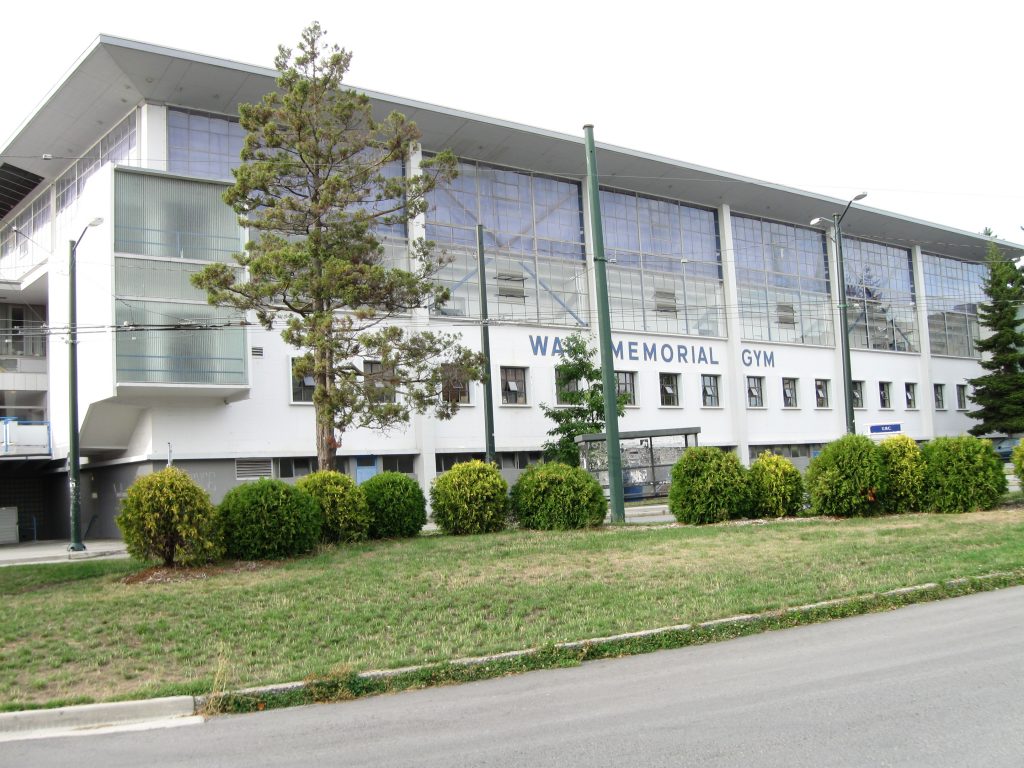
UBC was the scene for another sports-oriented opening this year: on February 23 the War Memorial Gym opened unofficially for a basketball game, almost exactly five years to the day a fund-raising campaign by students and alumni had begun. The new gym replaced a building opened in 1929, which had become too small for the university. The building was dedicated to the men and women of British Columbia who had served in the two world wars, and that fund-raising campaign had covered the whole province. The students kept regularly putting in money, so did alumni, so did the provincial government, the UBC Board of Governors and a lot of small, private donors all throughout B.C. That’s why it took five years!
On March 2 John Napier-Hemy wrote in the Ubyssey: “Throughout the $750,000 structure the emphasis has been on glass, which is both attractive and relatively cheap. Herculite doors, a ramp-like entrance, projecting stairs and an overall hangar-like appearance lend the gym an impression of striking modernity, which is in contrast to the staid, conservative architecture of other campus buildings.” The gym won a Massey Silver Medal for Architectural Design for Sharp, Thompson, Berwick and Pratt. There is permanent seating for 2,222 people. (One wonders if that striking number was deliberate.) They can add 600 bleacher seats if need be. The official opening took place as part of the University’s fall congregation ceremonies on October 26. In fact, the ceremonies were held inside the gym.
A UBC site has this: “Playing sports in this facility was unique because of the floor’s special spring. Folklore has it that horsehair had been inserted beneath the wood surface. ‘It was definitely springy, you knew you were on something softer,’ recalls former UBC basketball star Ken Winslade. The gym, whose architects included former UBC Olympic medal-winning rower Ned Pratt, is still considered ‘a classic basketball gym’ with seats above, the players below and an open space around the court—a treat for both the shooter and spectator. In addition, War Memorial was one of the very first gyms to have glass backboards and have its games broadcast on radio, most notably by a young play-by-play announcer named Jim Robson.”
Meanwhile, downtown, on May 11 there was a demonstration at the Hotel Vancouver of the latest weapon in the war against impaired drivers: the “Drunkometer.” Latest is a relative term: the device was invented by a US scientist in the 1930s. It was a machine that could determine the amount of alcohol in someone’s breath. A person would blow into a balloon, and the air in the balloon was then released into a chemical solution. If there was alcohol in the breath, the chemical solution changed color—and the greater the color change, the more alcohol in the breath.) The reign of the Drunkometer was brief: a simpler, more mobile device called the Breathalyzer would appear in 1954.
The Hotel Vancouver was the scene beginning August 24 of the first Canadian Chess Championship to be held in the city. The week long event featured a lot of chess-playing immigrants who had come to Canada after World War Two. The winner of this tournament was Povilas (Paul) Vaitonis, 41, a Lithuanian master who had moved to Hamilton, Ontario in advance of his country’s occupation by the Russians, and worked there as a cost accountant. A couple of interesting sidelights: one of the participants in that 1951 event was Vancouver’s Nathan Divinsky, who would later become a city councillor and the husband (from 1972 to their divorce in 1983) of Prime Minister-to-be Kim Campbell, and $500 of the expenses of putting the matches on was paid by John Prentice, a Vancouver forest industry executive whose support of chess in the city extended over decades.
One of the major show biz events of 1951 was the brief visit to Vancouver late in the year of movie star Yvonne De Carlo, 29. The Province, covering the visit, said on December 24 that Ms. De Carlo “hasn’t forgotten her home town.” (Born in Vancouver September 1, 1922 as Peggy Middleton, she made her first modest foray into showbiz as an usherette in Ivan Ackery’s Orpheum Theatre.) The Province reported that she had started her own movie company, calling it Vancouver Productions. Her first film was a biblical one to be shot in Austria in the spring. Her film credits don’t seem to include anything like that. Ah, well. She died January 8, 2007, aged 84.
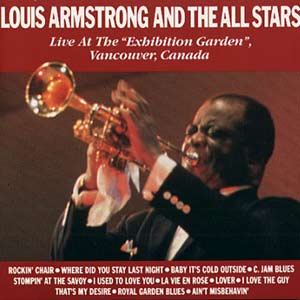
Louis Armstrong and The All Stars appeared at Exhibition Gardens January 26, and the concert was recorded. But the album wasn’t released until 2006, some 55 years after the event! Because the personnel backing Louis were all well-known we’ll name them here: Besides Louis on trumpet and vocal, there were Jack Teagarden (trombone, vocal), Barney Bigard on clarinet, Earl Hines at the piano, Arvell Shaw on string bass, Cozy Cole on drums and vocalist Velma Middleton. All-Stars indeed!
The Palomar Club re-opened June 18 with a sure-fire attraction: Frankie Laine. For a lot of years the Palomar at 713 Burrard at Alberni had been a Vancouver entertainment hot spot. It had opened May 23, 1937 with the Sandy De Santis band providing dance music. We mentioned Yvonne De Carlo above; she danced professionally at the Palomar in her early teens. The club was closed for a time (dates undetermined), then reopened with the Laine show.
The Workmen’s Compensation Board moved into a new head office at 707 West 37th Avenue this year. That minor event wouldn’t normally warrant inclusion in this history, but one of its claims the Board examined this year is irresistible: a Vancouver man had filed a claim for a head injury he said occurred when he bumped his head on a counter at work. Investigation proved later that the man had struck his head on a pool table while retrieving a ball he had knocked off the table.
Newspaper readers experienced a great increase in levity in 1951 when Eric Nicol, 31, began to write for the Province. UBC students were already familiar with him from his articles in the early 1940s in the Ubyssey, where he wrote as ‘Jabez’. BC Bookworld tells us that “Nicol had started to write occasional columns for the Vancouver News Herald and the Vancouver Province during the war. While he was in the RCAF he wrote many comedy skits that were performed to entertain the armed forces. After the war, Nicol returned to UBC for his M.A. in French Studies (1948) and spent one year in doctoral studies at Sorbonne. He then moved to London, England to write radio comedy series for Bernard Braden and Barbara Kelly of the BBC from 1950-51. He returned to Vancouver in 1951 to become a regular columnist with the Province.” He would go on, Bookworld relates, to eventually produce some six thousand newspaper columns, several stage plays, more scripts for radio and television and more than 30 books. One of his books is a history of the city (Vancouver) published in 1970 by Doubleday. In 2007, aged 87, Eric was still turning it out, albeit at an understandably slower pace.
On August 21, 1951 work started on the construction of China Creek Park. An article on the creek by Randolf Kjorrefjord, published by Vancouver Community College, has this: “The China Creek system was the largest drainage basin in Vancouver, with over 60 kilometres of creeks that converged at Clark Drive and 11th Avenue. Its name originated from a Chinese pig farm in that vicinity during the early 1880s. If the four creeks that fed Trout Lake are included, a total of nine creeks made up the entire China Creek system, which had the task of draining the district lying between Victoria Drive and Knight Road as far south as 45th Avenue.
“This great drainage system also had a rather impressive ravine, about 200 feet across at street level where it crossed Broadway, and north towards 7th Avenue. The ravine’s depth varied between 30 and 40 feet, over a distance of some 2,000 feet. During the 1920s and 30s, the City used China Creek ravine as a garbage dump. Eventually, local residents complained of the smell and potential health risk. In 1951, the mighty China Creek that had flowed for so many years and functioned as home to fish and young boys alike, was finally put to rest in a pipe. Apart from giving its name to the nearby park, it would be forgotten until the construction of King Edward Campus in the early 1980s.” Coho and chum salmon once swam here. Incidentally, the land on which the park sits was given to the city to settle an unpaid tax bill in 1923, though construction of the park did not begin until the date shown above.
The anti-potlatch law was repealed this year. The practice of the potlatch, central to Northwest Coast Native culture, had been outlawed in 1884. (A potlatch on McMillan Island, held in early September 1947, although illegal, was heavily attended by native people from all over the lower mainland.)
One of the world’s major forest industry firms was created in 1951 when Bloedel Stewart and Welch merged with the H.R. MacMillan Export Company. The chronology:
1911: a Seattle lawyer, Julius Bloedel, and two partners, John Stewart and Patrick Welch, formed a major logging firm called Bloedel, Stewart and Welch
1919: H.R. MacMillan, BC’s first chief forester, incorporated the H.R. MacMillan Export Co. in partnership with forester Whitford VanDusen. They would sell lumber products to foreign markets.
1951: Bloedel Stewart and Welch merged with H.R. MacMillan Export on October 31 to form MacMillan Bloedel. (In 1960 ‘MacBlo’ would take over the Powell River Company to become the MacMillan, Bloedel and Powell River Company, one of North America’s largest producers of newsprint. The name Powell River would be removed from the corporate title in 1966 and the company would become MacMillan Bloedel Ltd., headquartered in Vancouver.)
In other business, on March 21 Trans Mountain (later called Trans Mountain Pipeline) was incorporated, with plans to build a crude oil pipeline from Edmonton to its Burnaby Terminal. See the 1953 chapter for more.
In May, 1951 Wallace’s Burrard Dry Dock bought out Burdick’s North Vancouver Ship Repairs.
In transportation news, the Lougheed Highway was completed, accelerating development on the north shore of the Fraser.
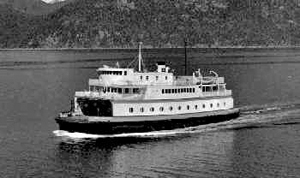
[Photo: www.tacomascene.com]
And Black Ball Ferries Ltd. made its appearance in BC this year. That company name went back a long way: the Black Ball Line started in 1816 with a trans-Atlantic clipper service between New York and Liverpool. Its famous flag showed a black ball against a red background. The founder’s great-grandson, Captain Alexander Marshall Peabody, chose the same flag for his fleet, the Puget Sound Navigation Company, which operated ferries on Puget Sound under the trade name Black Ball Line. That line was at one time the US’s largest privately-owned ferry system. Peabody sold the company to Washington State in 1950 . . . but not all of it. He organized Black Ball Ferries Ltd., a Canadian company, this year, transferred the motor ferries Bainbridge and Quillayute to Canadian registry and on August 11 started the Quillayute on the Horseshoe Bay-Gibsons run. He also retained the rights to the Seattle-Victoria route and terminals in Seattle, Port Angeles and Victoria. Black Ball would be bought by the BC government July 18, 1958, and become the foundation of the B.C. Ferries system. (Since 2003 the system has been an independent commercial company known as British Columbia Ferry Services Inc. It is no longer a crown corporation.)
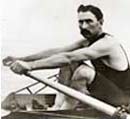
[Photo: BC Sports Hall of Fame]
We lost a couple of notable people in 1951: Baker W.C. Shelly died. He had made his fortune with 4x Bread. Shelly is notable for his contribution to the popularity of Grouse Mountain. After the 1925 construction of the first Second Narrows Bridge, Shelly had a vision that a popular resort could be placed atop Grouse if a road could be built to make it easier to get up there. So he formed a company, Grouse Mountain Highway and Scenic Resort Ltd., to put in a road up the mountain and build a chalet at the end of it. Grouse Mountain Chalet opened in November, 1926. (Shelly, incidentally, was a gifted amateur magician and in 1942 co-founded the Vancouver Magic Circle, still extant.)
Bob (Robert) Johnston, rower, died in Vancouver August 9, aged about 83. He was born in 1868, and was known as the “grand old man of rowing.” See 1898 for details on a world championship rowing event in Coal Harbour. Johnston coached the Vancouver Rowing Club which won a bronze medal in the 1932 Olympic double sculls event. He would be inducted posthumously into the B.C. Sports Hall of Fame in 1966. “A keen, cigar-chewing coach of champions.” The Vancouver Rowing Club has more detail on its web site.

![Princess Elizabeth and Philip, the Duke of Edinburgh, embarking on HMCS Crusader for Victoria October 21, 1951. [Photo: BC Archives NA-42089] [Photo: BC Archives NA-42089]](https://vancouverhistory.ca/wp-content/uploads/2020/12/3d20e1e8-e014-412d-9529-3f160b8ac42a-A36389-800x445.jpg)

